Wei Xi
Efficient Reasoning via Thought-Training and Thought-Free Inference
Nov 05, 2025Abstract:Recent advances in large language models (LLMs) have leveraged explicit Chain-of-Thought (CoT) prompting to improve reasoning accuracy. However, most existing methods primarily compress verbose reasoning outputs. These Long-to-Short transformations aim to improve efficiency, but still rely on explicit reasoning during inference. In this work, we introduce \textbf{3TF} (\textbf{T}hought-\textbf{T}raining and \textbf{T}hought-\textbf{F}ree inference), a framework for efficient reasoning that takes a Short-to-Long perspective. We first train a hybrid model that can operate in both reasoning and non-reasoning modes, and then further train it on CoT-annotated data to internalize structured reasoning, while enforcing concise, thought-free outputs at inference time using the no-reasoning mode. Unlike compression-based approaches, 3TF improves the reasoning quality of non-reasoning outputs, enabling models to perform rich internal reasoning implicitly while keeping external outputs short. Empirically, 3TF-trained models obtain large improvements on reasoning benchmarks under thought-free inference, demonstrating that high quality reasoning can be learned and executed implicitly without explicit step-by-step generation.
UniConvNet: Expanding Effective Receptive Field while Maintaining Asymptotically Gaussian Distribution for ConvNets of Any Scale
Aug 12, 2025Abstract:Convolutional neural networks (ConvNets) with large effective receptive field (ERF), still in their early stages, have demonstrated promising effectiveness while constrained by high parameters and FLOPs costs and disrupted asymptotically Gaussian distribution (AGD) of ERF. This paper proposes an alternative paradigm: rather than merely employing extremely large ERF, it is more effective and efficient to expand the ERF while maintaining AGD of ERF by proper combination of smaller kernels, such as $7\times{7}$, $9\times{9}$, $11\times{11}$. This paper introduces a Three-layer Receptive Field Aggregator and designs a Layer Operator as the fundamental operator from the perspective of receptive field. The ERF can be expanded to the level of existing large-kernel ConvNets through the stack of proposed modules while maintaining AGD of ERF. Using these designs, we propose a universal model for ConvNet of any scale, termed UniConvNet. Extensive experiments on ImageNet-1K, COCO2017, and ADE20K demonstrate that UniConvNet outperforms state-of-the-art CNNs and ViTs across various vision recognition tasks for both lightweight and large-scale models with comparable throughput. Surprisingly, UniConvNet-T achieves $84.2\%$ ImageNet top-1 accuracy with $30M$ parameters and $5.1G$ FLOPs. UniConvNet-XL also shows competitive scalability to big data and large models, acquiring $88.4\%$ top-1 accuracy on ImageNet. Code and models are publicly available at https://github.com/ai-paperwithcode/UniConvNet.
One Quantizer is Enough: Toward a Lightweight Audio Codec
Apr 07, 2025Abstract:Neural audio codecs have recently gained traction for their ability to compress high-fidelity audio and generate discrete tokens that can be utilized in downstream generative modeling tasks. However, leading approaches often rely on resource-intensive models and multi-quantizer architectures, resulting in considerable computational overhead and constrained real-world applicability. In this paper, we present SQCodec, a lightweight neural audio codec that leverages a single quantizer to address these limitations. SQCodec explores streamlined convolutional networks and local Transformer modules, alongside TConv, a novel mechanism designed to capture acoustic variations across multiple temporal scales, thereby enhancing reconstruction fidelity while reducing model complexity. Extensive experiments across diverse datasets show that SQCodec achieves audio quality comparable to multi-quantizer baselines, while its single-quantizer design offers enhanced adaptability and its lightweight architecture reduces resource consumption by an order of magnitude. The source code is publicly available at https://github.com/zhai-lw/SQCodec.
One Snapshot is All You Need: A Generalized Method for mmWave Signal Generation
Mar 27, 2025Abstract:Wireless sensing systems, particularly those using mmWave technology, offer distinct advantages over traditional vision-based approaches, such as enhanced privacy and effectiveness in poor lighting conditions. These systems, leveraging FMCW signals, have shown success in human-centric applications like localization, gesture recognition, and so on. However, comprehensive mmWave datasets for diverse applications are scarce, often constrained by pre-processed signatures (e.g., point clouds or RA heatmaps) and inconsistent annotation formats. To overcome these limitations, we propose mmGen, a novel and generalized framework tailored for full-scene mmWave signal generation. By constructing physical signal transmission models, mmGen synthesizes human-reflected and environment-reflected mmWave signals from the constructed 3D meshes. Additionally, we incorporate methods to account for material properties, antenna gains, and multipath reflections, enhancing the realism of the synthesized signals. We conduct extensive experiments using a prototype system with commercial mmWave devices and Kinect sensors. The results show that the average similarity of Range-Angle and micro-Doppler signatures between the synthesized and real-captured signals across three different environments exceeds 0.91 and 0.89, respectively, demonstrating the effectiveness and practical applicability of mmGen.
Stereo-LiDAR Depth Estimation with Deformable Propagation and Learned Disparity-Depth Conversion
Apr 11, 2024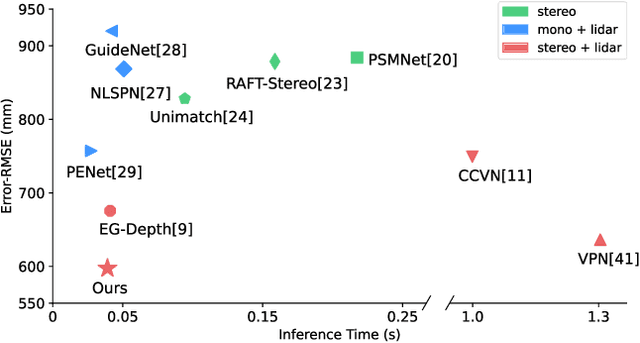
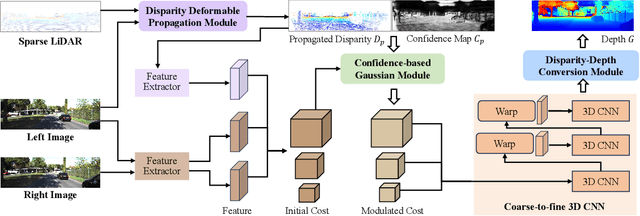
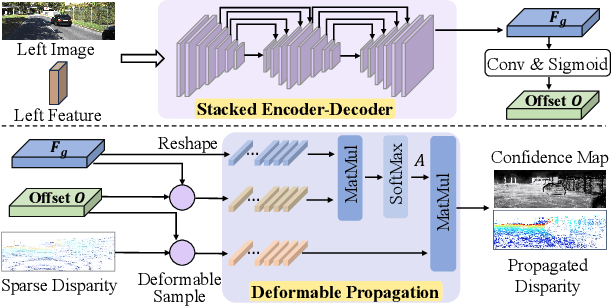

Abstract:Accurate and dense depth estimation with stereo cameras and LiDAR is an important task for automatic driving and robotic perception. While sparse hints from LiDAR points have improved cost aggregation in stereo matching, their effectiveness is limited by the low density and non-uniform distribution. To address this issue, we propose a novel stereo-LiDAR depth estimation network with Semi-Dense hint Guidance, named SDG-Depth. Our network includes a deformable propagation module for generating a semi-dense hint map and a confidence map by propagating sparse hints using a learned deformable window. These maps then guide cost aggregation in stereo matching. To reduce the triangulation error in depth recovery from disparity, especially in distant regions, we introduce a disparity-depth conversion module. Our method is both accurate and efficient. The experimental results on benchmark tests show its superior performance. Our code is available at https://github.com/SJTU-ViSYS/SDG-Depth.
FedFixer: Mitigating Heterogeneous Label Noise in Federated Learning
Mar 25, 2024Abstract:Federated Learning (FL) heavily depends on label quality for its performance. However, the label distribution among individual clients is always both noisy and heterogeneous. The high loss incurred by client-specific samples in heterogeneous label noise poses challenges for distinguishing between client-specific and noisy label samples, impacting the effectiveness of existing label noise learning approaches. To tackle this issue, we propose FedFixer, where the personalized model is introduced to cooperate with the global model to effectively select clean client-specific samples. In the dual models, updating the personalized model solely at a local level can lead to overfitting on noisy data due to limited samples, consequently affecting both the local and global models' performance. To mitigate overfitting, we address this concern from two perspectives. Firstly, we employ a confidence regularizer to alleviate the impact of unconfident predictions caused by label noise. Secondly, a distance regularizer is implemented to constrain the disparity between the personalized and global models. We validate the effectiveness of FedFixer through extensive experiments on benchmark datasets. The results demonstrate that FedFixer can perform well in filtering noisy label samples on different clients, especially in highly heterogeneous label noise scenarios.
Ground-Fusion: A Low-cost Ground SLAM System Robust to Corner Cases
Feb 22, 2024Abstract:We introduce Ground-Fusion, a low-cost sensor fusion simultaneous localization and mapping (SLAM) system for ground vehicles. Our system features efficient initialization, effective sensor anomaly detection and handling, real-time dense color mapping, and robust localization in diverse environments. We tightly integrate RGB-D images, inertial measurements, wheel odometer and GNSS signals within a factor graph to achieve accurate and reliable localization both indoors and outdoors. To ensure successful initialization, we propose an efficient strategy that comprises three different methods: stationary, visual, and dynamic, tailored to handle diverse cases. Furthermore, we develop mechanisms to detect sensor anomalies and degradation, handling them adeptly to maintain system accuracy. Our experimental results on both public and self-collected datasets demonstrate that Ground-Fusion outperforms existing low-cost SLAM systems in corner cases. We release the code and datasets at https://github.com/SJTU-ViSYS/Ground-Fusion.
UFDA: Universal Federated Domain Adaptation with Practical Assumptions
Nov 27, 2023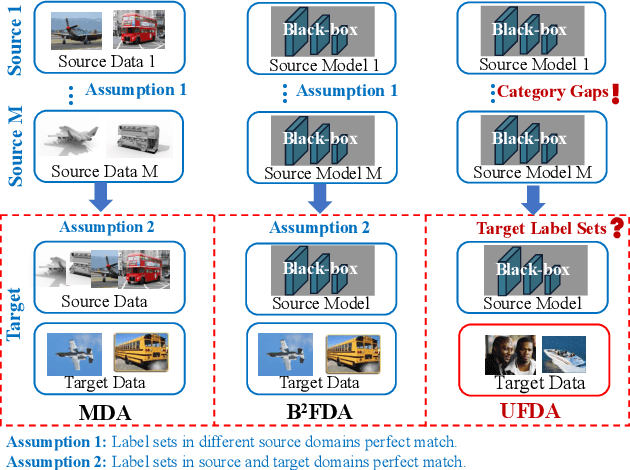


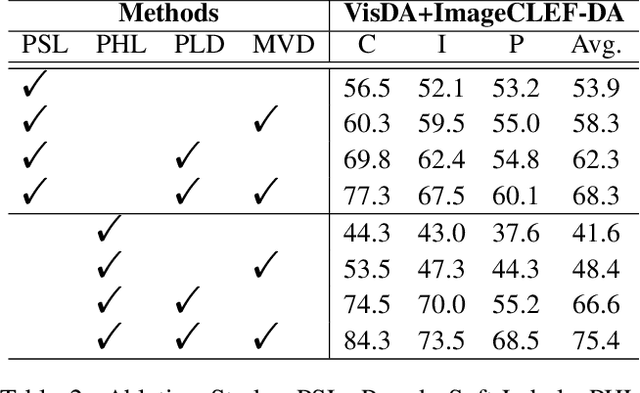
Abstract:Conventional Federated Domain Adaptation (FDA) approaches usually demand an abundance of assumptions, such as label set consistency, which makes them significantly less feasible for real-world situations and introduces security hazards. In this work, we propose a more practical scenario named Universal Federated Domain Adaptation (UFDA). It only requires the black-box model and the label set information of each source domain, while the label sets of different source domains could be inconsistent and the target-domain label set is totally blind. This relaxes the assumptions made by FDA, which are often challenging to meet in real-world cases and diminish model security. To address the UFDA scenario, we propose a corresponding framework called Hot-Learning with Contrastive Label Disambiguation (HCLD), which tackles UFDA's domain shifts and category gaps problem by using one-hot outputs from the black-box models of various source domains. Moreover, to better distinguish the shared and unknown classes, we further present a cluster-level strategy named Mutual-Voting Decision (MVD) to extract robust consensus knowledge across peer classes from both source and target domains. The extensive experiments on three benchmarks demonstrate that our HCLD achieves comparable performance for our UFDA scenario with much fewer assumptions, compared to the previous methodologies with many additional assumptions.
Meta Generative Flow Networks with Personalization for Task-Specific Adaptation
Jun 16, 2023Abstract:Multi-task reinforcement learning and meta-reinforcement learning have been developed to quickly adapt to new tasks, but they tend to focus on tasks with higher rewards and more frequent occurrences, leading to poor performance on tasks with sparse rewards. To address this issue, GFlowNets can be integrated into meta-learning algorithms (GFlowMeta) by leveraging the advantages of GFlowNets on tasks with sparse rewards. However, GFlowMeta suffers from performance degradation when encountering heterogeneous transitions from distinct tasks. To overcome this challenge, this paper proposes a personalized approach named pGFlowMeta, which combines task-specific personalized policies with a meta policy. Each personalized policy balances the loss on its personalized task and the difference from the meta policy, while the meta policy aims to minimize the average loss of all tasks. The theoretical analysis shows that the algorithm converges at a sublinear rate. Extensive experiments demonstrate that the proposed algorithm outperforms state-of-the-art reinforcement learning algorithms in discrete environments.
Mastering Strategy Card Game via End-to-End Policy and Optimistic Smooth Fictitious Play
Mar 07, 2023

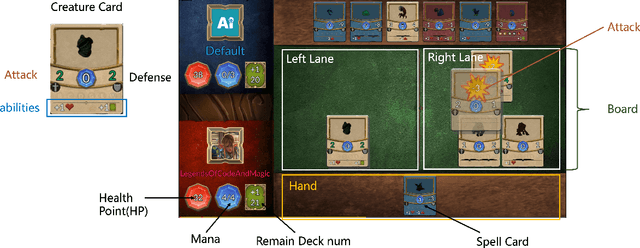

Abstract:Deep Reinforcement Learning combined with Fictitious Play shows impressive results on many benchmark games, most of which are, however, single-stage. In contrast, real-world decision making problems may consist of multiple stages, where the observation spaces and the action spaces can be completely different across stages. We study a two-stage strategy card game Legends of Code and Magic and propose an end-to-end policy to address the difficulties that arise in multi-stage game. We also propose an optimistic smooth fictitious play algorithm to find the Nash Equilibrium for the two-player game. Our approach wins double championships of COG2022 competition. Extensive studies verify and show the advancement of our approach.
 Add to Chrome
Add to Chrome Add to Firefox
Add to Firefox Add to Edge
Add to Edge